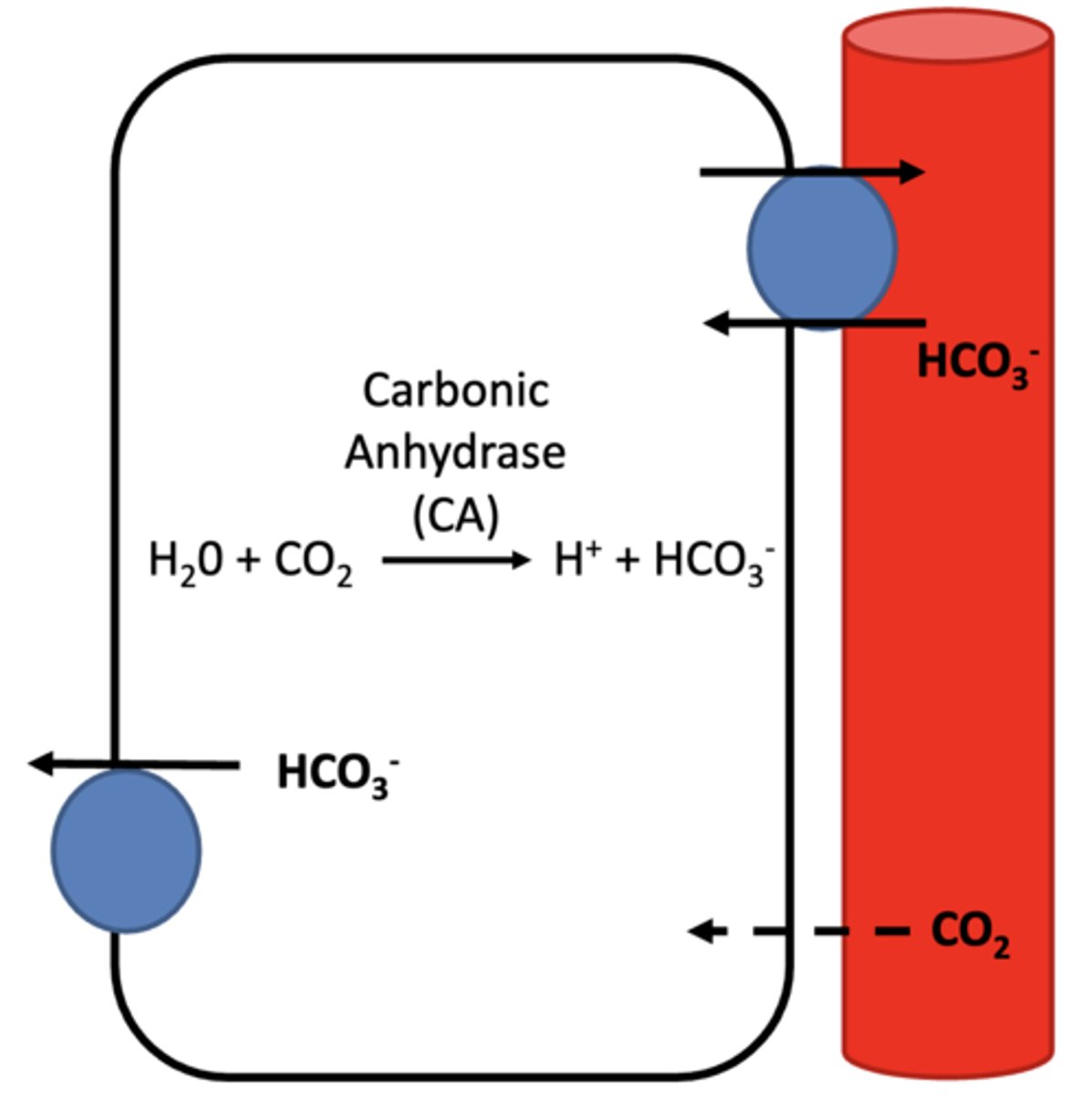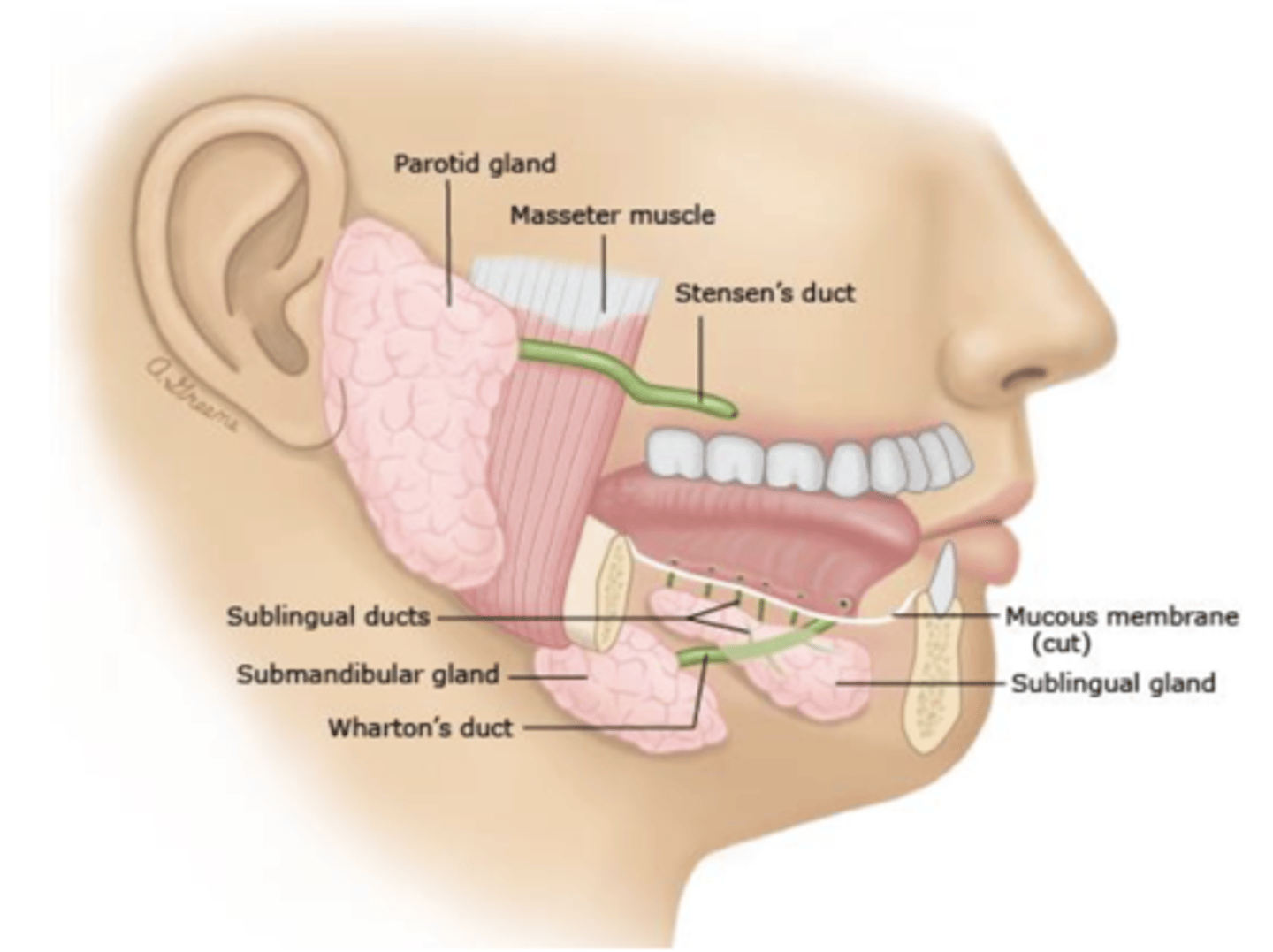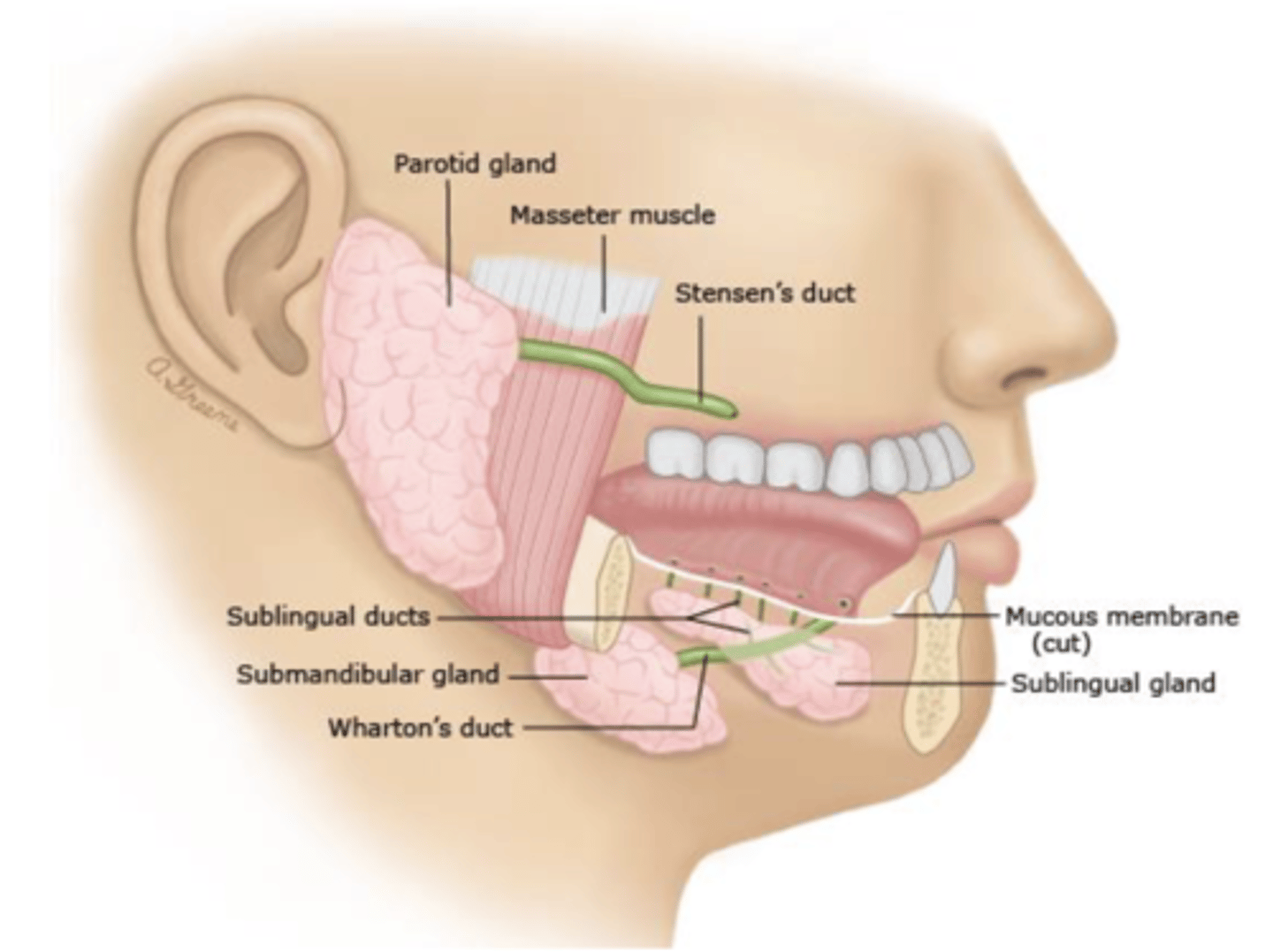Gastrointestinal Physiology: Salivary Glands and Saliva Formation
1/69
There's no tags or description
Looks like no tags are added yet.
Name | Mastery | Learn | Test | Matching | Spaced |
|---|
No study sessions yet.
70 Terms
What is the role of salivary glands in digestion?
begin the digestive process
-amylase --> cleaves carbs into simple sugars
-lipase --> cleaves triglycerides to glycerol & carbon chains (fatty acids & monoglycerides)
what organ secretes pepsin?
stomach
pepsin
enzyme secreted by the stomach that cleaves proteins to large peptides
What is the role of bile excreted by the liver?
emulsifies fasts which aids in fat digestion
What enzymes are secreted by the pancreas, and what are their functions?
-pancreatic amylase --> cleaves carbs to simple sugars
-lipase --> cleaves triglycerides to glycerol & carbon chains (fatty acids & monoglycerides)
-trypisin & other proteases--> cleave proteins/large peptides to amino acids
Where does the bulk of digestion & absorption occur?
small intestine
True or False: The small intestine removes water and ions
False ==> The large intestine removes water & ions
ingestion
eating = taking in nutrients
digestion
using physical & chemical means to break down complex organic molecules into smaller usable parts
absorption
pulling in digested molecules into the cells of the digestive tract & then into blood
egestion
the removal if waste food materials from body
*cellulose = fiber
What are the 3 phases of digestion?
-cephalic phase/reflex phase --> begins prior to food entry; salivary gland secretion major component
-gastric phase --> begins w/ arrival of food in stomach
-intestinal phase --> begins as partially digested food enters the duodenum
What marks the beginning of the cephalic phase of digestion?
begins prior to food entry
What is a major component of the cephalic phase of digestion?
salivary gland secretion
What marks the beginning of the gastric phase of digestion?
arrival of food in the stomach
What marks the beginning of the intestinal phase of digestion?
begins as partially digested food enters the duodenum
Describe the Cephalic Phase of Digestion
the first phase of digestion = integrated response to prepare the body for a meal
-stimuli = thoughts, site, sound, & smell of food
-response = increase PNS outflow
-effect = salivation, gastric & pancreatic secretion & release of bile to the GI tract
Approximately _______L are ingested.
2L
What volume is secreted into the GI tract?
7L
In general, what stimulates secretion in the GI tract?
-local effect of luminal contents
-Autonomic Stimulation
>PNS --> usually increases secretion
>SNS --> usually decreases secretion
-hormonal & paracrine stimulation
Which cranial nerves are responsible for salivation?
-CNVII
-CNIX
which cranial nerves are responsible for foregut outflow?
CNX
What are some positive regulators of saliva production?
-thought of food
-smell of food
-sight of food
-act of chewing
-nausea
What are some negative regulators of saliva production?
-dehydration
-sleep
-fear
-anticholinergic drugs
True or False: The protein content of saliva can alter oral homeostais.
True ==> oral homeostasis is dependent upon saliva & its content of proteins
Describe Reflex Salivary Flow v. Salivary Flow after positive stimulation
-reflex salivary flow --> low "resting" rate
-positive stimuli (intense taste or chewing stimuli) --> ten-fold increase in salivation
Common Causes of Xerostomia
-medications (esp. anticholinergics)
-nerve damage
-autoimmune destruction (ex: Sjorgen's)
-Infection (ex: HIV)
-radiation
-severe dehydration
What are common complications of Xerostomia?
-dental caries & disease
-infections --> oral thrush (fungal)
-speaking is difficult
-swallowing difficult
-decreased taste
Why is bicarbonate secreted in the GI tract?
-buffering pH fluctuations
-neutralizing gastric acid
-providing optimal pH for digestive enzymes in duodenum
-helps solubilize macromolecules --> mucin & bile acids
What is the source of bicarbonate in GI tract?
-plasma
-CO2 enters from GI lumen --> converted into HCO3 via carbonic anhydrase --> secreted into GI tract

What are the 3 major salivary glands?
-parotid gland
-submandibular gland
-sublingual gland
stensen's duct
duct that drains the parotid gland
*located opposite to the upper 2nd molar

wharton's duct
duct that drains the submandibular gland & some of the sublingual glands into the floor of the mouth near the frenulum of tongue

There are approximately ________ minor salivary glands in the mouth
600
True or False: Serous acinar cells have watery secretions
True
True or False: Mucous acinar cells have watery secretions
False==> have viscous secretions
What are the components of salivary secretions from acinar cells?
-alpha amylase --> begins carbohydrate digestion
-lipase --> begins lipid digestion by converting triglycerides to fatty acids & monoglycerides
-mucin --> important for bolus formation & swallowing food being ingested
-extracellular fluid --> similar to ionic composition of plasma
What is the role of smaller ducts within salivary glands?
modify saliva
What is the role of larger ducts within salivary glands?
act as conduits (channels for salivary flow)
Describe the basic functional anatomy of salivary glands.
many lobes divided into lobules with acini attached to ducts
-acinar cells form the saliva
>serous cells --> watery secretions
>mucous cells --> viscous secretions
-smaller ducts --> modify saliva
-larger ducts --> act as conduits

Where does 90% of salivary secretion come from?
the major salivary glands ==> parotid, submandibular, & sublingual
alpha-amylase
component of saliva secreted by acinar cells of salivary glands to begin carbohydrate digestion
*inactivated by low pH
True or False: Alpha-amylase travels with the bolus into the stomach to complete carbohydrate digestion there.
False ==> Not possible b/c alpha amylase is inactivated by low pH
Why is lipase a component of saliva?
to begin lipid digestion by converting triglycerides to fatty acids & monoglycerides
Why is mucin a component of saliva?
important for bolus formation & swallowing food being ingested
True or False: The extracellular fluid component of saliva is hypertonic to plasma
False ==> ECF component of saliva is isotonic to plasma
What is the role of ductal cells in salivary glands?
-actively modify the ion content of saliva by absorption & secretion (small ducts)
-form channels for salivary flow into mouth (large ducts)
True or False: Saliva is hypotonic to plasma
True
Describe the tonicity of saliva. How does saliva compare to plasma from the time it is initially secreted by acinar cells to when it enters the oral cavity?
acinar cells secrete saliva that is isotonic to plasma (w/ Na+, K+, Cl-, HCO3-, & water) --> saliva enter intercalated ducts that have aquaporins -->water & salt reabsorbed --> saliva enters striated & excretory ducts that don't have aquaporins --> Na+, Cl- reabs into tissues (& HCO3- secreted into saliva) --> hypotonic saliva excreted into oral cavity

Why is saliva hypotonic to plasma?
b/c salt is reabs from salivary secretion as it moves thru ducts while most ductal cells are impermeable to water (don't have aquaporins)
*only a small section of ducts have aquaporins (intercolated ducts)
What is the purpose of creating hypotonic saliva?
aids in the detection of salt in the diet
Where are the aquaporins located on intercolated ductal cells?
apical membranes
True or False: Parasympathetic stimulation of salivary glands results in watery saliva production
True ==> increased secretion of fluid & ions
True or False: Sympathetic stimulation of salivary glands results in watery saliva production
False ==> results in increased protein content of saliva
True or False: GI hormones don't play a role in the regulation of salivary secretion.
True
Which gland contributes the most to unstimulated saliva production?
submandibular gland (69%)
Which gland contributes the most to stimulated saliva production?
parotid gland (69%)
What percent of unstimulated saliva production are each of major salivary glands responsible for?
-submandibular gland = 69%
-parotid gland = 26%
-sublingual gland = 5%
What percent of unstimulated saliva production is the submandibular gland responsible for?
69%
What percent of unstimulated saliva production is the parotid gland responsible for?
26%
What percent of unstimulated saliva production is the sublingual gland responsible for?
5%
What percent of stimulated saliva production are each of the major salivary glands responsible for?
-parotid gland = 69%
-submandibular glands = 26%
-sublingual glands = 5%
What percent of stimulated saliva production is the parotid gland responsible for?
69%
What percent of stimulated saliva production is the submandibular gland responsible for?
26%
What percent of stimulated saliva production is the sublingual gland responsible for?
5%
sialoliths
stones in salivary glands ==> can be broken/removed, but tend to reoccur
*most common in parotid glands
sialadenitis
bacterial infection of salivary glands
Diseases of Salivary Glands
-sialoliths --> stones
-sialadenitis --> bacterial infection
-viral infection (ex: Mumps makes salivary glands swell very large)
-sjorgen's syndrome = chronic autoimmune disease
-benign pleomorphic adenomas
-cancerous tumors (rare)
What is the purpose of secreting bicarbonate in saliva?
-important in protecting the mouth from pH shifts
-maintain neutral pH for amylase & lipase activity
If all autonomic stimulation increases the secretion of saliva, what is the difference between parasympathetic and sympathetic stimulation of the salivary glands?
-PNS --> increased secretion of fluids & ions from acinar & ductal cells; controls the majority of salivary secretion to increase volume
-SNS --> increase fluid, ion, & protein secretion but a minor contributor to increase fluid volume